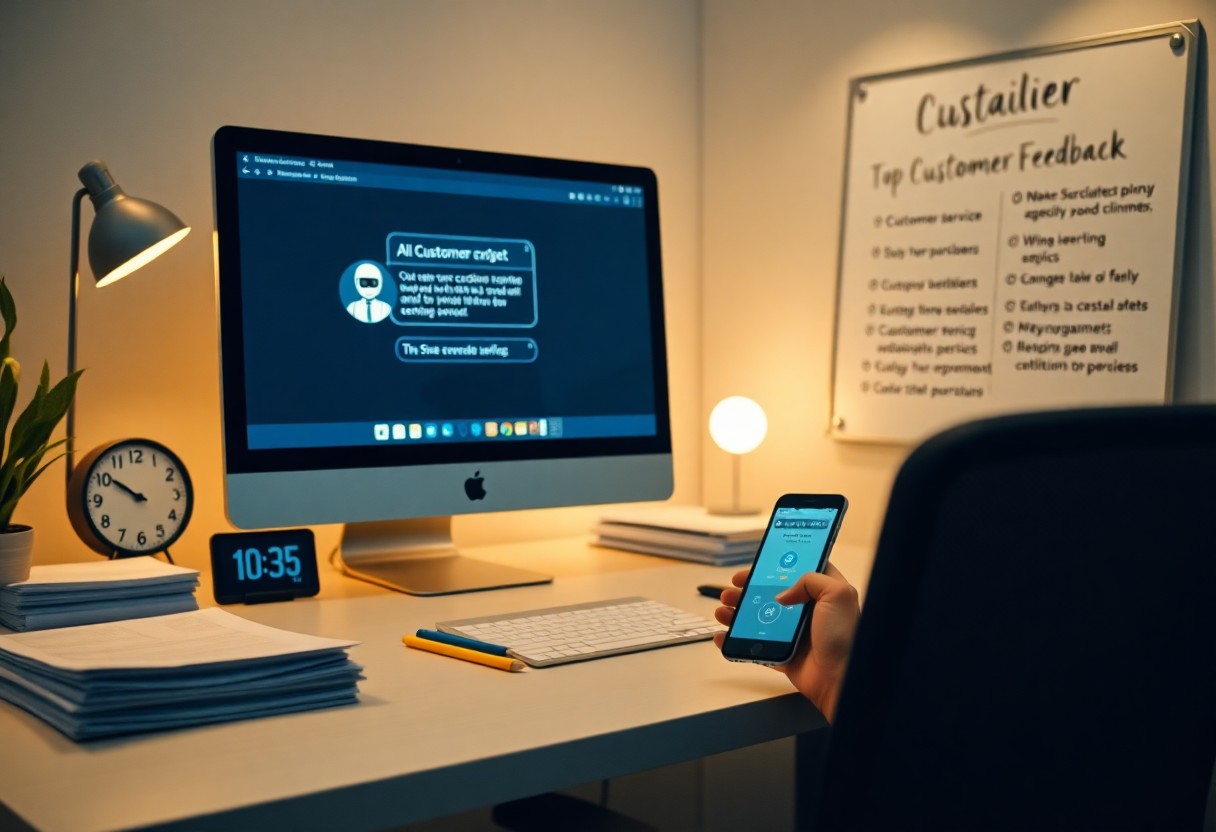Chatbots have revolutionized customer interaction, providing small business owners like you with the opportunity to streamline operations and enhance efficiency. By implementing AI chatbots, you can automate repetitive tasks, improve customer engagement, and significantly reduce response times. This technology allows you to focus on more strategic initiatives while your chatbot handles routine inquiries, ultimately saving you 10+ hours every week. Discover five effective ways these intelligent tools can empower your business.
Key Takeaways:
- AI chatbots can handle customer inquiries 24/7, reducing the need for constant human supervision.
- Automated responses to FAQs streamline communication, saving time for staff to focus on other tasks.
- Integrating chatbots with CRM systems enhances customer engagement and supports lead generation.
- Chatbots can assist in scheduling appointments, minimizing the back-and-forth for time management.
- Data collected by chatbots provides insights into customer preferences, informing business decisions.

Automating Customer Service: A Game Changer for Time Management
Streamlining FAQs and Common Queries
Utilizing AI chatbots to address frequently asked questions (FAQs) can drastically reduce the time you and your team spend managing customer inquiries. Instead of fielding repetitive questions like store hours, return policies, or product availability, chatbots can provide instant, accurate responses. This approach not only enhances efficiency but also allows you to focus your energy on more complex issues that require human intervention. For instance, implementing a chatbot can free up as much as 30% of customer service time, enabling your team to handle high-value tasks instead.
Consider the simplicity of integrating a chatbot on your website or social media platforms. Once programmed with your most common queries, these bots can operate around the clock, providing customers with immediate answers regardless of the time of day. This immediate availability cultivates a seamless customer experience. As a result, your customers won’t have to wait for business hours to get their questions answered, which can lead to increased satisfaction and a higher rate of customer retention.
The strategic use of chatbots also allows you to gather data on common queries. By analyzing which questions are frequently asked, you can identify areas for improvement in your product or service offerings. This not only enhances customer satisfaction but also aids in refining your business model, allowing for more informed decision-making down the line.
Enhancing Personalized Interaction without Human Overhead
AI chatbots are capable of facilitating personalized interactions without the need for human oversight. By leveraging customer data, these chatbots can deliver tailored responses based on individual preferences and past interactions. For instance, if you run an online retail store, a chatbot can suggest products based on previous purchases or browsing history. This level of personalization enhances the customer experience and fosters loyalty without adding significant workload to your staff.
The magic lies in the chatbot’s ability to analyze customer behavior in real-time. When a customer engages with the bot, it can offer relevant recommendations or respond to inquiries personalized to that specific user. This may include upselling or cross-selling strategies that human agents will often overlook due to high volume or time constraints. In studies, businesses utilizing personalized recommendations through chatbots have seen an increase in sales conversions by as much as 20%, showcasing their effectiveness.
Moreover, the AI can track customer interactions and preferences, enabling it to refine its responses over time. As more users engage, your chatbot becomes more adept at understanding subtle customer needs, allowing for increasingly nuanced and relevant interaction. This evolution not only benefits customers but also enhances your brand’s reputation as a responsive and customer-centric business.
Personalized interaction through AI chatbots brings a high touch to customer service without the typical human resource demands. With machine learning capabilities, these chatbots evolve, ensuring your business stays ahead in providing tailored experiences that keep customers engaged. Customers appreciate interactions that feel personal, leading to stronger loyalty and repeat business.
24/7 Availability: Ensuring No Customer Left Behind
Expanding Service Hours with Minimal Additional Cost
Integrating AI chatbots into your customer service strategy can significantly expand your service hours without the burden of additional staffing costs. Traditional customer support often necessitates multiple shifts of employees, leading to high overhead expenses related to salaries and benefits. In contrast, chatbots provide a seamless solution, operating around the clock and handling inquiries at any hour. This not only reduces labor costs but also allows you to allocate those savings to other business areas, like marketing or product development, enhancing overall efficiency.
Consider the potential impact on customer satisfaction when your business is available 24/7. Customers who can access assistance whenever they need it are far less likely to become frustrated and will appreciate your brand’s commitment to service. Data shows that 60% of customers expect businesses to be available outside normal working hours, and failure to meet these expectations can lead to lost sales opportunities. By leveraging a chatbot, you can ensure that no customer inquiry is ignored and every potential sale is nurtured, regardless of the time of day.
Enhancing your business’s service hours also aligns with changing consumer behaviors, particularly among younger demographics who often conduct transactions in the late evening or early morning. By using AI chatbots to manage these interactions, you tap into new consumer habits, leveraging their preferences for quick, efficient communication. For instance, a retail store that implemented a chatbot for late-night inquiries saw a 25% increase in online sales during off-hours, translating into a significant revenue boost without the costs associated with live staff being present.
Capturing Leads After Business Hours
AI chatbots excel in lead generation by engaging customers even after your business closes for the day. When traditional business hours end, chatbots stand ready to answer questions, provide product information, and collect contact details from potential leads. This capability ensures you can convert interest into actionable leads while maximizing your time and resources. A survey conducted by Drift found that up to 75% of leads prefer to connect with businesses outside traditional hours, highlighting the opportunity to capture interest that would otherwise slip away.
The information captured by chatbots during these after-hours interactions can be invaluable. By gathering data points like emails, phone numbers, and specific customer interests, you build a robust database of leads that your sales team can pursue the following day. This proactive approach can lead to quicker follow-ups, enhancing your chances of closing sales by connecting with leads while their interest is still fresh. Utilizing the capabilities of AI chatbots amplifies your effectiveness in transforming inquiries into loyal customers.
Incorporating chatbots for after-hours engagement gives your small business a competitive edge. Whether you run a service-oriented company or an e-commerce site, being accessible to potential customers at all times will create a positive impression and ensure that you never miss out on valuable opportunities.
Data-Driven Insights: The Unseen Efficiency Tool
Leveraging Customer Interactions for Improved Decision Making
Your AI chatbot inherently records interactions with customers, providing a treasure trove of data for analysis. Each conversation can reveal your clientele’s most common concerns, questions, or preferences. By systematically evaluating these interactions, you can identify recurring themes that inform your product development and marketing strategies. For instance, if multiple customers frequently ask about a specific feature, it may indicate a demand that warrants further exploration or enhancement.
Incorporating feedback gathered from AI chatbots also allows you to pivot your strategy in real-time. Suppose a segment of your users expresses dissatisfaction with a particular service aspect; you can quickly adjust your approach based on immediate data rather than relying on outdated surveys or anecdotal evidence. This agility ultimately translates to a more responsive and customer-centric business model, ensuring you remain relevant and competitive.
Utilizing these insights not only guides your operational decisions but also fosters a deeper connection with your customers. When you address their needs and opinions reflected in chatbot dialogues, customer loyalty strengthens. Brands that embrace customer feedback tend to report higher engagement and satisfaction rates, proving that leveraging AI analytics paves the way for improved decision-making processes.
Identifying Trends that Save Time and Resources
AI chatbots also excel at identifying trends over time, allowing you to streamline operations and allocate resources more efficiently. By analyzing engagement metrics, such as peak interaction times or the most common inquiries, you can optimize staffing schedules and website features. If data shows that your customers most frequently reach out on certain days, you can adjust your support staffing levels accordingly, ensuring that you provide timely responses without over-committing resources during slower periods.
Another aspect of trend identification is recognizing shifts in customer behavior. If patterns reveal a growing interest in a specific product or service, you can preemptively boost inventory or launch targeted marketing campaigns, saving both time and money. Companies that actively monitor these trends are often in a better position to capitalize on emerging market demands, positioning themselves ahead of competitors who may lag in adopting AI insights.
The efficiency gains from trend identification can be staggering. Businesses that implement AI-driven insights for operational changes often report reductions in spending on unnecessary labor hours and increased sales from better inventory management. For example, a small retail shop increased its profitability by 15% after adjusting stock levels based on chatbot engagement data, demonstrating the tangible benefits of leveraging AI for insights.
Operational Efficiency: Reducing Internal Workload
Handling Routine Tasks that Drain Employee Productivity
AI chatbots take over repetitive tasks that typically consume a significant amount of your team’s time. Consider customer inquiries about operating hours, service details, and product availability. Instead of having your employees repeatedly provide the same information, a chatbot equipped with the right data can respond instantly, ensuring customers receive prompt service while freeing your staff to focus on more valuable tasks. For instance, a local café implementing a chatbot saw a 35% decrease in routine inquiries directed to staff, allowing baristas to concentrate on enhancing customer experiences.
Not only do chatbots handle FAQs, but they also manage appointment bookings, reminders, and follow-ups. Imagine your scheduling process streamlined by an AI system that can coordinate with customer calendars and send timely notifications. A small business offering wellness services reported a dramatic 50% reduction in appointment scheduling time after introducing a chatbot. This transformation not only elevated operational efficiency but also improved customer satisfaction, as clients appreciated the ease of booking their sessions.
Deploying advanced chatbot technology means your workforce can dedicate their skills toward projects that foster innovation and growth rather than getting bogged down in administrative tasks. With chatbots handling everything from inventory checks to order confirmations, your staff is empowered to strategize and implement new initiatives that could drive your business forward. By reallocating time from mundane tasks to strategic thinking, you will set your small business up for sustained success in an increasingly competitive landscape.
Integrating with Existing Business Systems
AI chatbots enhance operational efficiency through seamless integration with your current business systems. An effective chatbot can connect with CRM tools to provide personalized customer experiences while maintaining up-to-date customer data. Integration reduces the chances of errors that arise from manual data entry and ensures that your team has access to accurate information in real-time, enhancing the overall workflow. Businesses that have successfully integrated chatbots with their CRMs often report faster response times and improved customer satisfaction ratings.
Moreover, connecting chatbots to e-commerce platforms streamlines ordering processes. When customers can check product availability or make purchases directly through a chatbot, the friction between browsing and buying disappears. This integration can lead to higher conversion rates. A boutique clothing store that implemented a chatbot linked to its online store experienced a 20% increase in sales within the first quarter of deployment, demonstrating the power of systems working together efficiently.
Integrating chatbots with existing systems not only improves data accuracy but also fosters a cohesive operational environment where all tools work in harmony. Your chatbot can pull crucial analytics, track key performance indicators, and generate reports automatically, keeping you informed without the need for extensive manual effort. The result is a streamlined approach to business operations that significantly enhances productivity across your team.
Cost Savings: The Real Financial Benefits of AI Chatbots
Comparing Labor Costs vs. Chatbot Investment
You might be surprised by how much you spend on customer service and support teams, especially when including salaries, training, and benefits. In contrast, investing in an AI chatbot can drastically lower those expenses. For example, if you currently employ two full-time customer service representatives at an average annual cost of $40,000 each, your total expense amounts to $80,000 a year. Conversely, a robust AI chatbot system can be acquired for a one-time fee or a subscription cost of around $10,000-$20,000 annually, depending on the features you choose.
Cost Comparison Table
| Expense Type | Estimated Cost |
|---|---|
| Two Customer Service Reps | $80,000/year |
| AI Chatbot Solution | $10,000 – $20,000/year |
Once you factor in the ongoing costs of employee turnover and retraining, the difference becomes even more pronounced. Employee turnover in customer service can reach up to 30%, leading to costs not just in hiring, but also in lost productivity. Each time you hire a new employee, you spend significant resources on recruitment and training. An AI chatbot runs 24/7 without the need for breaks, sick days, or vacation time, allowing you to optimize customer service without constant overspending on labor.
From Customer Acquisition to Retention: Understanding Long-Term Savings
Investing in AI chatbots enhances your customer acquisition strategy while also improving retention rates. With 78% of consumers expecting quick responses to inquiries, you can’t afford to keep potential customers waiting. A chatbot can handle initial customer queries, qualifying leads around the clock. This immediate engagement increases your chances of converting inquiries into actual sales, thereby boosting your bottom line significantly. Moreover, with added capabilities like personalized suggestions or proactive feedback gathering, your chatbot enhances the customer experience, fostering loyalty over time.
AI chatbots can also aid in gathering valuable insights through customer interactions. These insights can drive targeted marketing strategies or help improve your products and services based on actual customer preferences. You reduce costs by avoiding traditional marketing campaigns that may not resonate, as your chatbot data provides a clearer understanding of your audience. Ultimately, these enhanced relationships lead to reduced churn, keeping your customers coming back for more and saving you on acquisition costs in the long run.
This long-term relationship-building translates into substantial savings. While upfront costs for implementing a chatbot may seem significant, the return on investment becomes evident when considering the decreased expenditure on both customer acquisition and retention efforts. A well-designed AI chatbot doesn’t merely aid in immediate responses but evolves into a strategic asset that effectively drives revenue while minimizing ongoing operational costs.

Elevating User Experience: The Key to Customer Loyalty
Faster Response Times and Improved Satisfaction Ratings
AI chatbots can significantly enhance your customer interactions by providing instantaneous responses to inquiries. Studies have shown that businesses implementing chatbots see a marked increase in customer satisfaction ratings, often exceeding 90%. While traditional customer service methods may require customers to wait on hold for several minutes, chatbots operate around the clock, ensuring that no query goes unanswered. This prolific availability translates into an enhanced user experience, fostering a stronger connection between you and your customers.
When customers receive immediate assistance, they’re more likely to perceive your brand as attentive and engaged. For instance, a small business like an online retail store used AI chatbots to manage common questions about order statuses. As a result, they reduced response times from several hours to mere seconds, elevating customer satisfaction. In practice, by streamlining routine interactions, chatbots free up your human agents to tackle more complex issues, leading to an overall boost in your service quality.
The implications extend beyond surface-level interactions. A customer who experiences swift resolution through an AI chatbot is far more likely to return to your business in the future. This efficiency not only directly improves satisfaction ratings but also drives repeat purchases. Your reputation as a client-centric business becomes firmly established, contributing to brand loyalty as customers come to expect and rely on your superior service.
Fostering Brand Loyalty Through Consistent Engagement
Consistent engagement channels created by AI chatbots facilitate brand loyalty by maintaining a constant line of communication with your customers. This capability allows you to send personalized messages tailored to individual needs, preferences, and purchasing behavior. Tailored recommendations not only enhance your customers’ shopping experience but also encourage repeat visits. With chatbots, you can seamlessly follow up after a purchase, ask for feedback, or inform customers of new products, reinforcing their connection to your brand.
Additionally, chatbots maintain engagement through regular updates, fostering a sense of community around your brand. Notably, brands that incorporate interactive features via chatbots often report an increase in customer retention rates. If customers feel they are part of a dynamic relationship rather than simply a transactional experience, the likelihood of their loyalty grows immensely. Engagement metrics can soar as customers interact regularly with your content and promotions, proving the effectiveness of continuous conversation.
Building relationships with your customers through consistent engagement helps create a more personal connection. By addressing their specific needs and preferences, you cultivate trust, which directly influences their purchasing decisions. For example, a local coffee shop that utilizes AI chatbots for loyalty rewards can engage customers by automatically sending promo codes and personalized offers based on their previous purchases, strengthening affinity towards the brand and generating excitement for future interactions.
Preparing for the Future: Staying Competitive in a Changing Landscape
The Role of AI in Industry Evolution
The integration of AI into various industries transforms the landscape in which small businesses operate. AI tools are not just futuristic concepts; they are reshaping existing business models to enhance efficiency and effectiveness. For instance, AI-powered analytics can crunch large datasets to uncover actionable insights, enabling you to make data-driven decisions with confidence. The evolving algorithms improve over time, allowing for predictions that can streamline your operations, reduce waste, and ultimately increase profit margins.
While larger companies often have the resources to implement extensive AI systems, small businesses can leverage accessible AI solutions without exhaustive investments. SaaS (Software as a Service) platforms offer cost-effective AI applications tailored to your specific needs. You gain immediate access to tools that can analyze customer interactions, optimize marketing campaigns, and provide insights that were previously reserved for big players. This democratization of AI empowers you to stay competitive, ensuring that your small business can adapt and innovate in real-time.
The pace of change is rapid, with forecasts predicting that AI will contribute $15.7 trillion to the global economy by 2030. By embracing AI now, you position your business not just to survive but to thrive in this evolving landscape. The early adoption of such technologies becomes a unique selling proposition, making your business more attractive to tech-savvy customers who favor efficiency and innovation in their purchasing decisions.
Anticipating Customer Needs with Smart Technologies
Smart technologies like AI-driven chatbots allow you to anticipate customer needs and preferences effectively. With machine learning algorithms analyzing customer data, you gain insights that enable personalized interactions. For example, if a customer frequently inquires about a specific product, your chatbot can acknowledge this history and suggest complementary items, enhancing their shopping experience. This level of personalization not only drives sales but fosters customer loyalty.
Businesses that use advanced data analytics report a marked improvement in customer engagement. By leveraging predictive analytics, you can tailor marketing strategies based on predictive models that assess customer behavior and preferences. This informs your decisions on what products to promote, when to reach out to potential customers, and how to adjust your service offerings based on their specific needs. Anticipating customer desires translates into proactive engagement, ensuring that your marketing efforts resonate with your target audience.
Staying ahead of customer expectations requires a proactive approach. By utilizing AI tools, you are not merely reacting to trends but setting the pace in your industry. Further investment in these technologies will dramatically enhance your ability to predict customer needs and stay one step ahead, allowing you to create tailored strategies that enhance customer satisfaction and retention.
Final Words
Hence, implementing AI chatbots in your small business can dramatically transform the way you operate, saving you valuable time each week. By automating routine tasks such as customer inquiries, appointment scheduling, and basic support, you can redirect your focus towards strategic initiatives that drive growth and innovation. With chatbots working around the clock, your business can maintain a consistent presence, ensuring that customers receive immediate responses regardless of the time of day. This not only enhances customer satisfaction but also builds loyalty, as clients appreciate prompt and efficient communication.
As you integrate AI chatbots into your daily operations, their capacity to handle multiple interactions simultaneously allows you to scale your customer service without the need for additional personnel. This efficiency leads to improved productivity within your team, enabling your staff to dedicate their efforts towards more complex tasks. You can analyze the insights generated from chatbot interactions to gain a deeper understanding of customer preferences, which can inform your marketing strategies and product offerings. In doing so, you create a responsive environment that adapts to the evolving needs of your clientele.
Conclusively, leveraging AI chatbots can indeed free up 10 or more hours of your schedule each week, offering substantial administrative relief and the opportunity to enhance various aspects of your business. By embracing this technology, you position your small business to operate more efficiently while staying competitive in a rapidly changing marketplace. The time you save can be reinvested into activities that foster growth and innovation, ensuring the long-term sustainability of your enterprise. Adopting AI chatbots not only streamlines workflows but also empowers you to respond proactively to challenges and opportunities alike.



